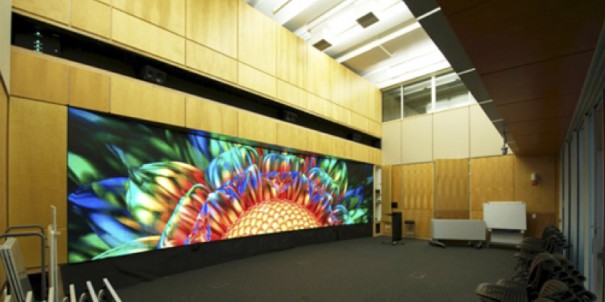Un videowall construido con MicroTiles es utilizado por la universidad de Stanford como herramienta educativa
RP Visuals ha diseñado un videowall de 439 metros cuadrados con MicroTiles de Christie para sustituir el antiguo sistema de proyección que la Universidad de Stanford tenía en el Wallenberg Hall.
La Universidad de Stanford (California) ha utilizado la tecnología MicroTiles de Christie para diseñar un videowall de 439 metros cuadrados que es utilizado como herramienta de aprendizaje. RP Visuals ha sido la empresa encargada de diseñar el marco de este videowall compuesto por 32 MicroTiles de ancho por 6 de alto y que se ha instalado a dos metros del suelo en una de las aulas del Wallenberg Hall, ocupando casi la totalidad de la pared. Esta estancia se utiliza para impartir diferentes asignaturas de periodismo y ciencias sociales, así como otros eventos puntuales.
Las aulas del Wallenberg Hall son utilizadas por la Universidad de Stanford como espacios para experimentar con nuevas formas de enseñanza y aprendizaje en sus áreas temáticas. El personal del Wallenberg, tanto profesores como técnicos, trabajan en estrecha colaboración con la facultad para crear nuevas actividades y proporcionar herramientas que apoyen el aprendizaje que se imparte en la universidad.
Inaugurado en 2002, la Fundación Wallenberg decidió que era hora de actualizar la infraestructura de visualización de este edificio y sustituir los viejos proyectores por la tecnología de Christie MicroTiles. Según Bob Smith, Director of Technology Services de la Office of the Registrar, “la primera fila se quedaba a menudo vacía dada la mala visibilidad y si se ocupaban todos los asientos eran los propios asistentes los que proyectaban sombras en la pantalla”. Esta no es la primera vez que este centro docente hace uso de los MicroTiles de Christie, ya que hace dos años los utilizó para la pantalla de video que instalado en el centro de visitantes.
Para el gran videowall de la sala del Wallenberg Hall se precisaba un sistema que ofreciera una gran resolución y permitiera visualizar múltiples presentaciones que ejecutan simultáneamente en una gran variedad de configuraciones.
“Los MicroTiles permiten que la gente se siente más cerca de la pantalla, que podamos ajustar con flexibilidad la retórica visual de forma se agranden los contenidos más relevantes y se reduzcan los menos críticos, desplazando las imágenes por diferentes zonas de la pantalla según las necesidades del momento”, comenta Bob Smith.
Con una paleta mucho más amplia que las LCD convencionales, Christie MicroTiles muestra colores limpios y realistas. Su modular tecnología de visualización permite realizar configuraciones digitales en casi cualquier forma y tamaño.
Te gustó este artículo?
Suscríbete a nuestro RSS feed y no te perderás nada.
• Sección: Casos de estudio, DESTACADO, Digital signage, Display, Formación















